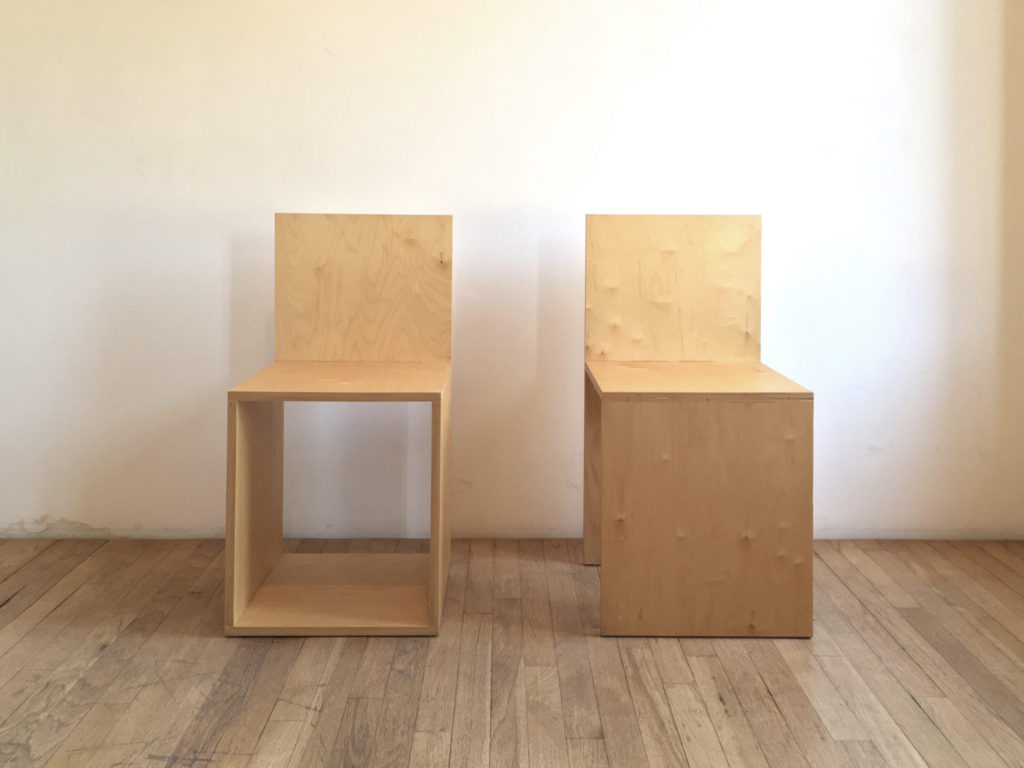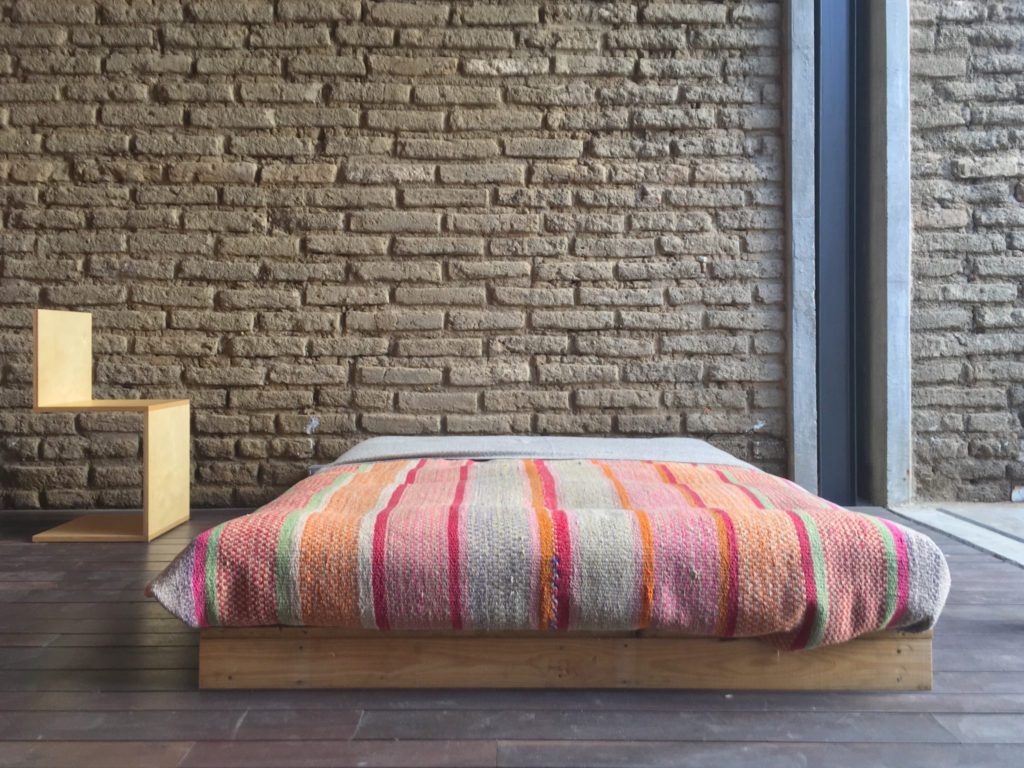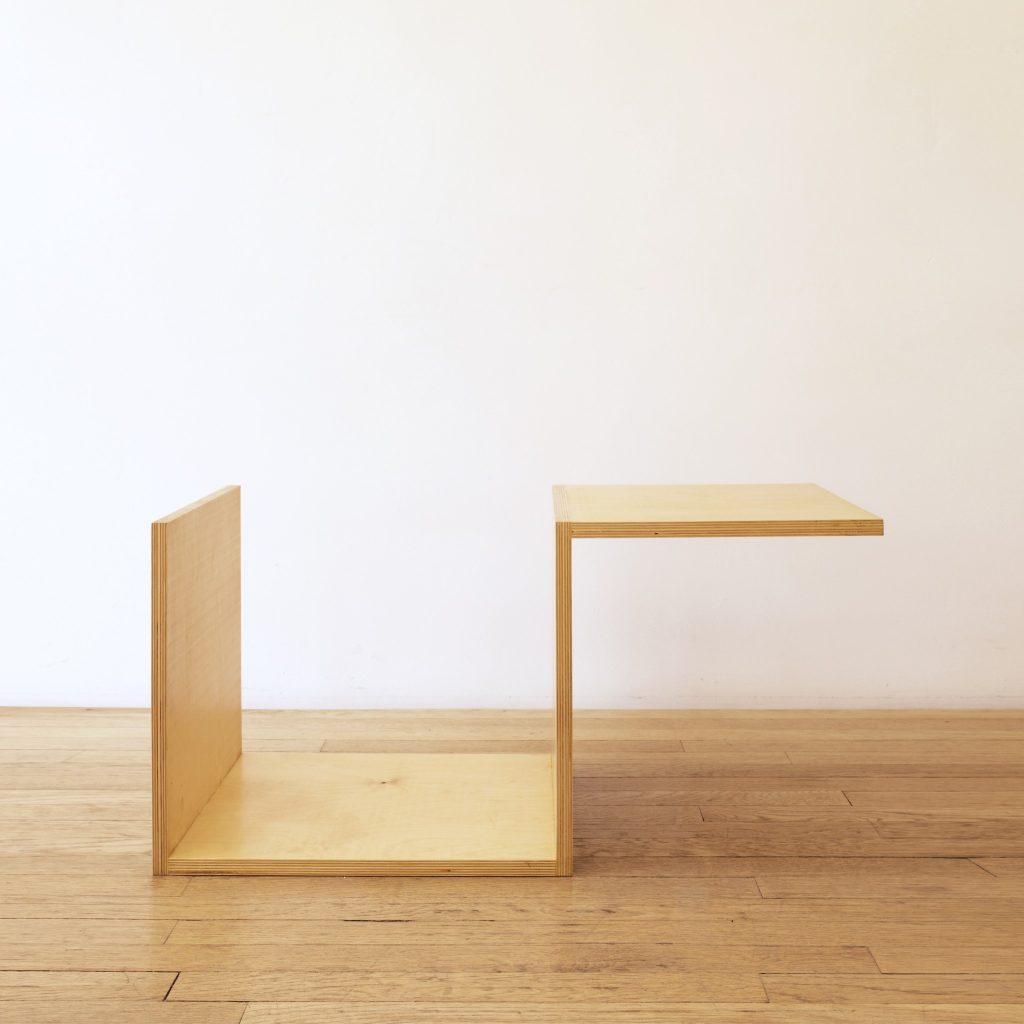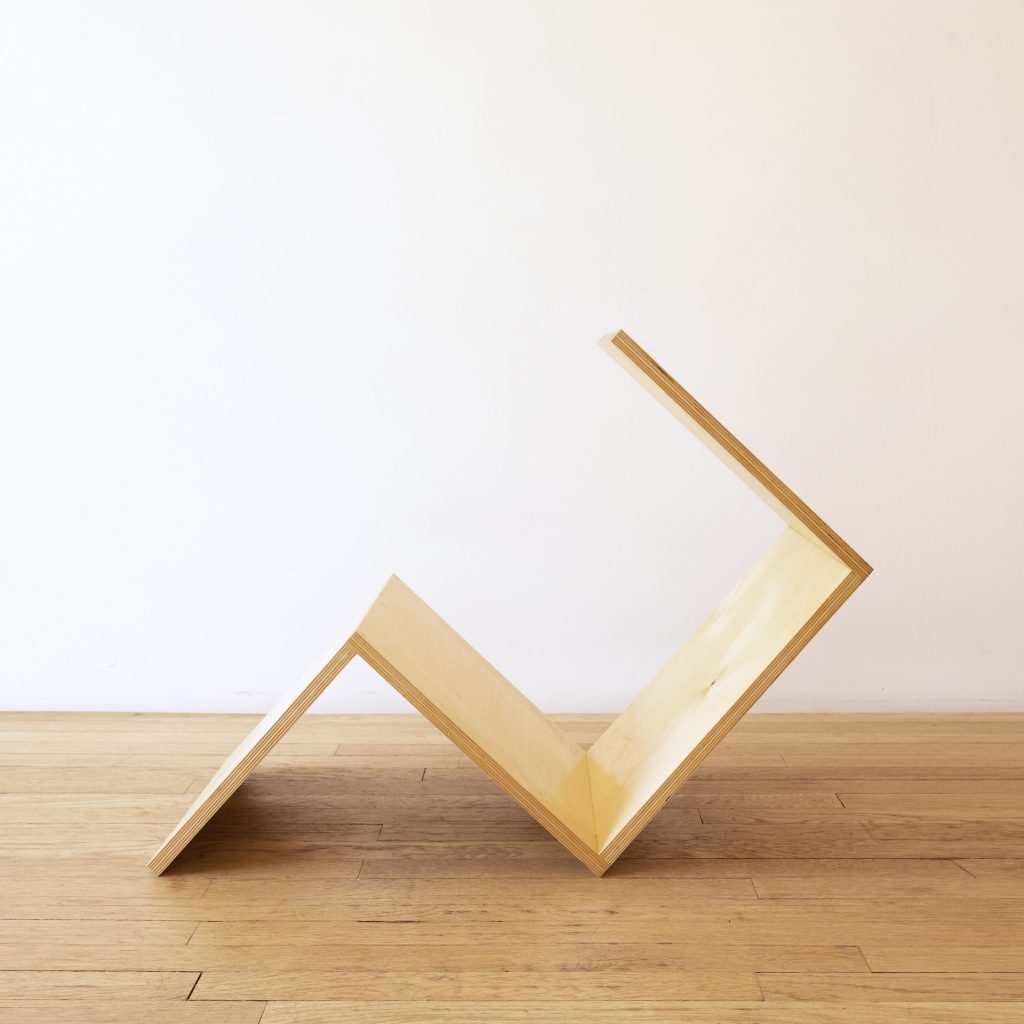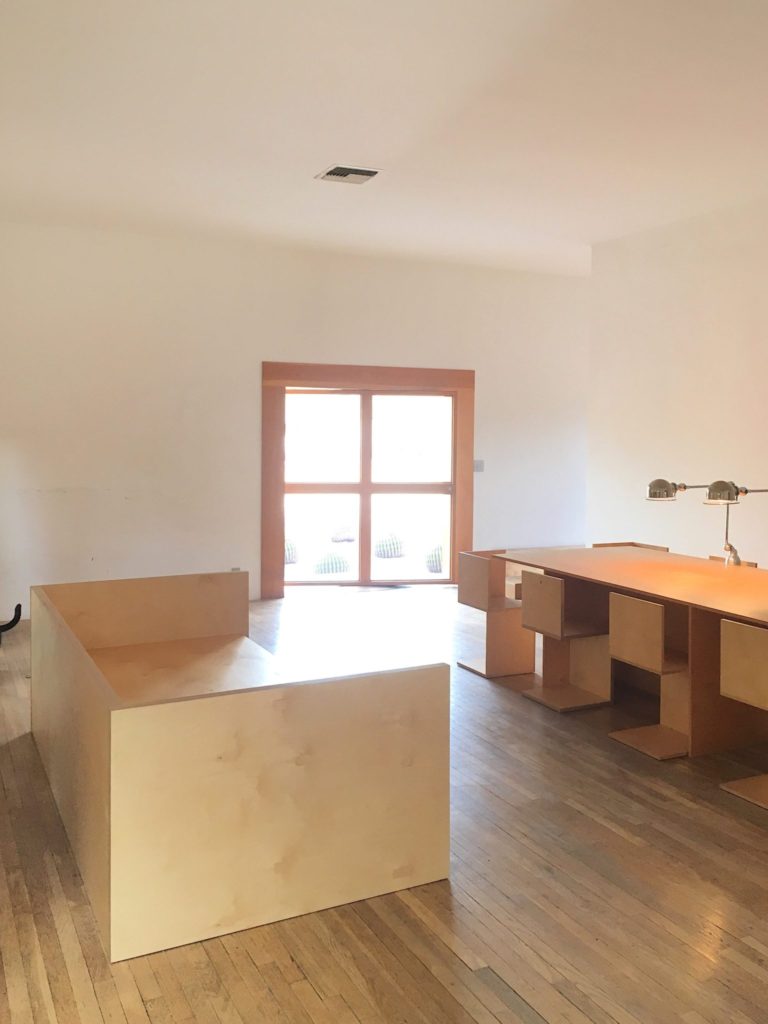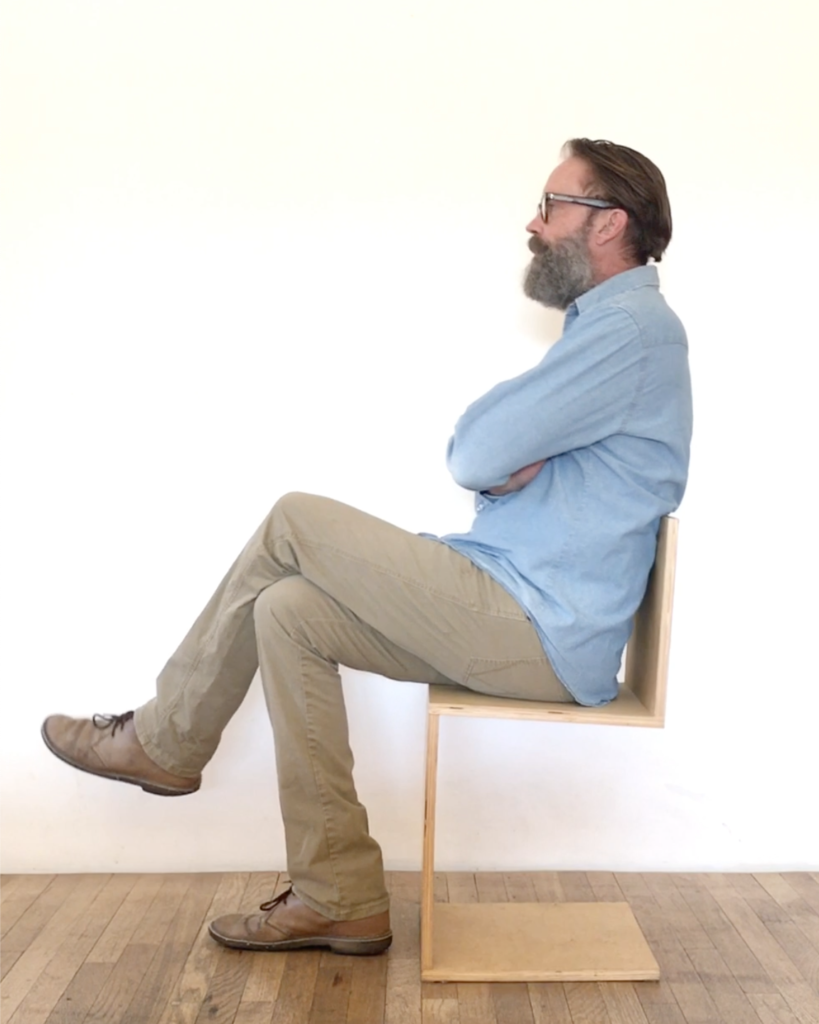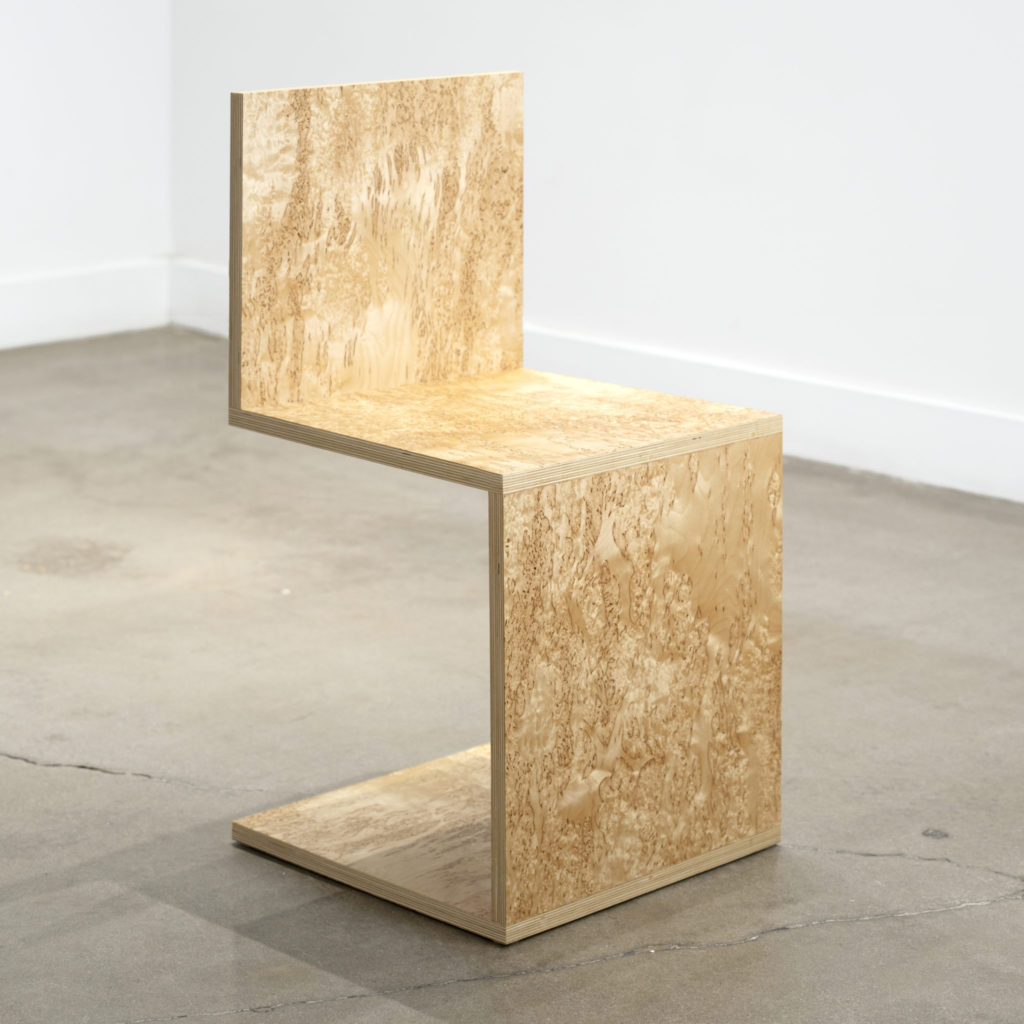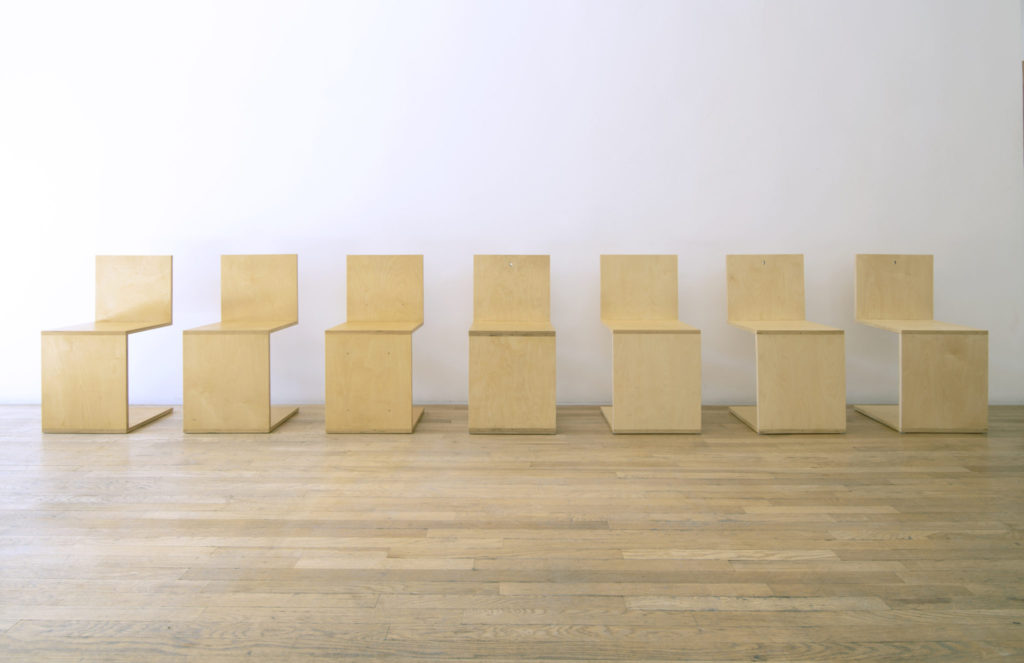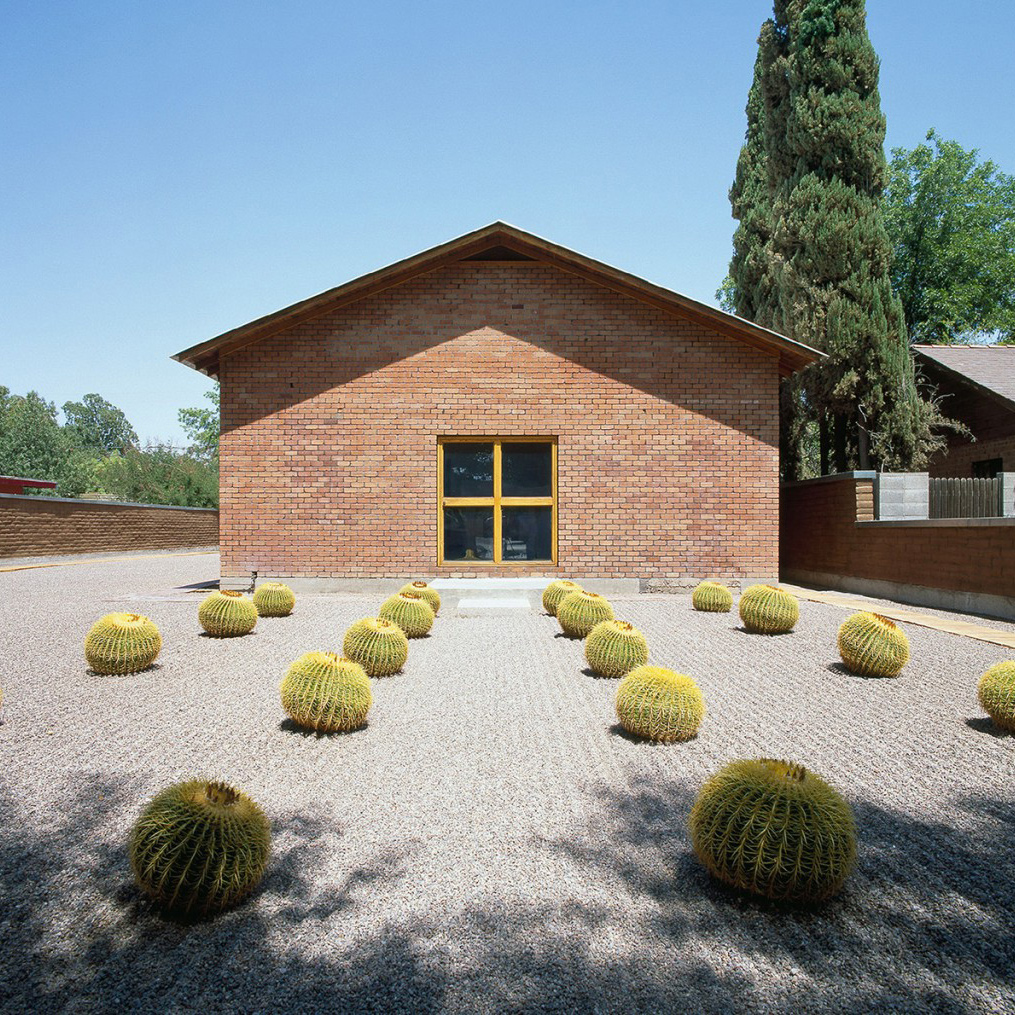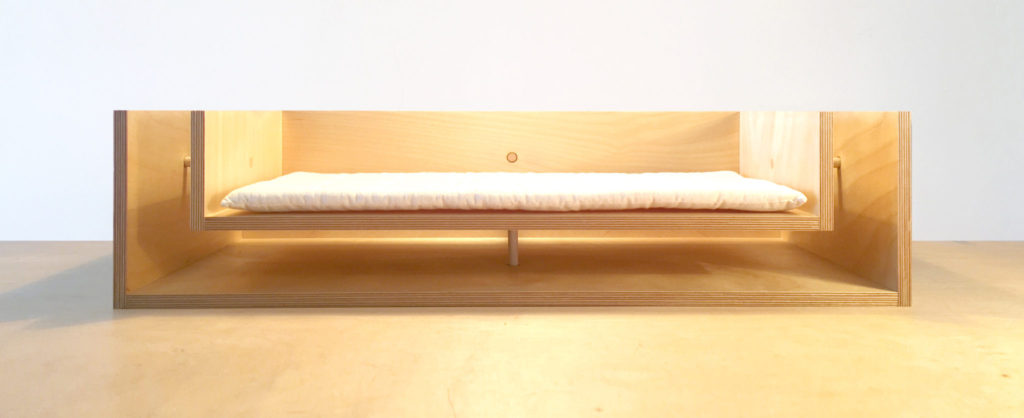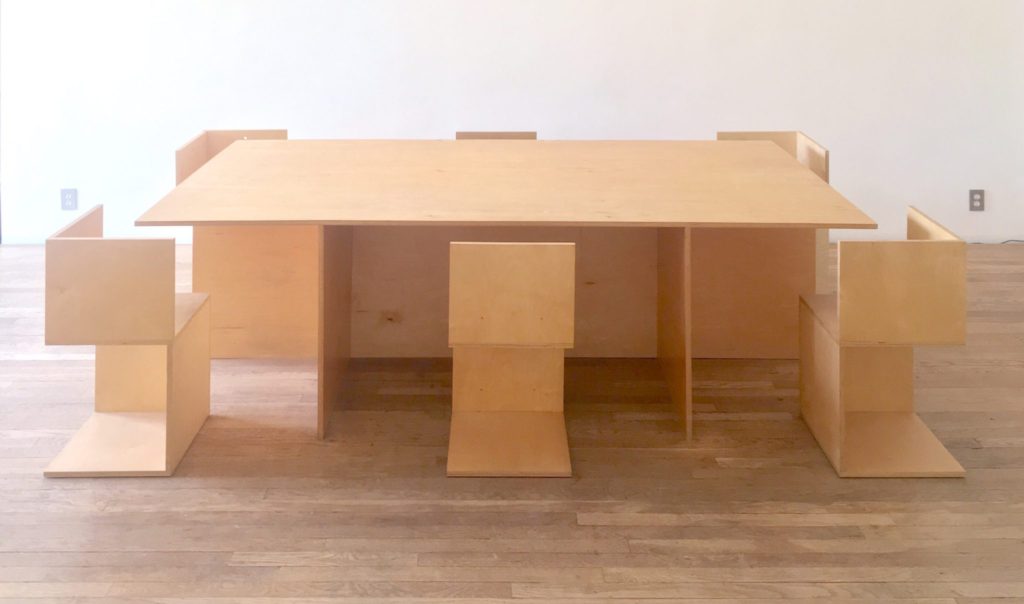Weed Furniture is based on my
discovery to join and even cantilever 18 mm
plywood at a 90° angle with enough
strength to support a human being. The
structure could be compared to
bones where the strength is greater
towards the joint but without being literal
like Joris Laarman’s Bonechair.
In 1999 my first experience in
carpentry was to copy the Donald Judd
Plywood Desk Number 75 as a case
study. Upon seeing his furniture for the first
time in Marfa, Texas, having
recently completed my studies in Basel/
Switzerland where simple was con-
sidered sacrosanct, I felt an
immediate connection. My only alteration
was to move the two shorter supports
closer together because I needed a table,
not a desk, and because the new
1:2:1 proportions of the lateral openings
seemed to be more generous to me.
(Donald Judd Plywood Desk 75 copy
with Weed Furniture Numbers 1, 2, and 3
shown above). The desk/table
is a Donald Judd copy and not part of Weed
Furniture. It can still be ordered here.
The work for Weed Furniture,
on the other hand, started in 2010 based
on a fascination with the profile of
the cantilevered Number 1. It was years later
that I discovered the legacy of
this form that has been documented
back to Mart Stam and his experi-
ments with threaded steel conduit. My con-
straints were that it be eco-
nomical in cost as well as form. There-
fore all material needed to be already
commercially available. The planes must be
straight with 90° and, unlike
Stam’s, sharp as possible angles
between them. This came from a personal
preference for simple straight lines
and generous proportions intensified
through my work in Switzerland.
In the beginning I considered extruding
the entire form from a solid piece of
aluminum but soon realized that the size of
the extrusion press needed to
push a billet through a profile that large
just wasn’t practical or even possible.
As I still had the Donald Judd 75
copy I thought, why not try it in plywood?
Shortly after I first made the Judd 75
copy an experienced carpenter warned
me that moving those supports
closer together and further from the edges
would cause the top to sag over time.
It is twenty-years later and as you can
see above the top is still flat.
At the time, this warning piqued my curiosity
about the possibilities of plywood.
Plywood is wonderful.
It is exceptionally durable and flexible.
It is earthy, honest, and warm, along
with being commercially available. Unlike
aluminum extruding though,
plywood required that each flat plane
be a separate piece and joined together some-
how. In the beginning I considered
Hans Gugelot’s box joints on the Ulmer
Hocker but soon realized he
had included a support dowel for good reason.
I found the acute angles of the dove-
tail joints on Gerrit Rietveld’s Zig Zag
chair too special and realized
they also wouldn’t be strong enough for 90°
angles. It wasn’t until seriously thinking
about the nature of plywood that I had the idea
for the simple butt joint. I’ve been
asked why I didn’t miter the joints. I would
only say that acute angles are formally
stingy. Shaker carpenters seem to have had
a high level understanding of this.
In 2018 after eight Weed Furniture Number
1 prototypes and eight years of testing
I finally had success with the joint complying
with the Business and Institutional
Furniture Manufacturers Association’s
rigorous durability and stability standards.
I constantly question what I do.
Recently, I started to wonder if maybe Weed
Furniture is too similar to
Judd Furniture. They share straight
lines, sharp 90° angles, generous proportions
based on human scale, and plywood.
While researching derivation
in furniture design, I discovered an interview
by Design Week with Jay Osgerby, a
partner in Barber and Osgerby, who have
designed furniture for Vitra.
“I don’t think people should be
frightened of producing work that has
references to other work,
that’s a natural part of what we do as creative
people. My advice would be to innovate
through advances in technology, which have
always enabled real newness.”
This excerpt, which has been
included with permission and may be read
in its entirety here, along with writing
this manifesto, has made this
clear to me: Due to the serious thought
into the nature of plywood, Weed
Furniture is able to explore the very essence
of furniture form without
having to rely on braces or supports.
Some pieces even allow great
amounts of flexibility in the plywood. With-
out the joint discovery the
furniture would collapse by direct and/
or shear stress from the weight of a human being and therefore not be furniture.
Therefore, even though I’ve everytime
been more interested in just making things
plain and simple, I would say
that Weed Furniture is on a new way.
(With many thanks to Miro Chun and
Uzyel Karp for their thoughtful editing and
suggestions.)
Weed Furniture is based on my
discovery to join and even cantilever 18 mm
plywood at a 90° angle with enough
strength to support a human being. The
structure could be compared to
bones where the strength is greater
towards the joint but without being literal
like Joris Laarman’s Bonechair.
In 1999 my first experience in
carpentry was to copy the Donald Judd
Plywood Desk Number 75 as a case
study. Upon seeing his furniture for the first
time in Marfa, Texas, having
recently completed my studies in Basel/
Switzerland where simple was con-
sidered sacrosanct, I felt an
immediate connection. My only alteration
was to move the two shorter supports
closer together because I needed a table,
not a desk, and because the new
1:2:1 proportions of the lateral openings
seemed to be more generous to me.
(Donald Judd Plywood Desk 75 copy
with Weed Furniture Numbers 1, 2, and 3
shown above). The desk/table
is a Donald Judd copy and not part of Weed
Furniture. It can still be ordered here.
The work for Weed Furniture,
on the other hand, started in 2010 based
on a fascination with the profile of
the cantilevered Number 1. It was years later
that I discovered the legacy of
this form that has been documented
back to Mart Stam and his experi-
ments with threaded steel conduit. My con-
straints were that it be eco-
nomical in cost as well as form. There-
fore all material needed to be already
commercially available. The planes must be
straight with 90° and, unlike
Stam’s, sharp as possible angles
between them. This came from a personal
preference for simple straight lines
and generous proportions intensified
through my work in Switzerland.
In the beginning I considered extruding
the entire form from a solid piece of
aluminum but soon realized that the size of
the extrusion press needed to
push a billet through a profile that large
just wasn’t practical or even possible.
As I still had the Donald Judd 75
copy I thought, why not try it in plywood?
Shortly after I first made the Judd 75
copy an experienced carpenter warned me
that moving those supports
closer together and further from the edges
would cause the top to sag over time.
It is twenty-years later and as you can
see above the top is still flat.
At the time, this warning piqued my curiosity
about the possibilities of plywood.
Plywood is wonderful. It is exceptionally
durable and flexible. It is
earthy, honest, and warm, along with
being commercially available.
Unlike aluminum extruding though,
plywood required that each flat plane
be a separate piece and joined
together somehow. In the beginning I
considered Hans Gugelot’s box joints on the
Ulmer Hocker but soon realized he
had included a support dowel for good
reason. I found the acute angles of the dove-
tail joints on Gerrit Rietveld’s Zig Zag
chair too special and realized
they also wouldn’t be strong enough for 90°
angles. It wasn’t until seriously thinking
about the nature of plywood that I had the
idea for the simple butt joint. I’ve been
asked why I didn’t miter the joints. Hopefully
my earlier description of acute angles
helps clarify this. Shaker carpentry seems
to have understood this very well.
In 2018 after eight Weed Furniture Number
1 prototypes and eight years of testing
I finally had success with the joint complying
with the Business and Institutional
Furniture Manufacturers Association’s
rigorous durability and stability standards.
I constantly question what I do.
Recently, I started to wonder if maybe Weed
Furniture is too similar to
Judd Furniture. They share straight
lines, sharp 90° angles, generous proportions
based on human scale, and plywood.
While researching derivation
in furniture design, I discovered an interview
by Design Week with Jay Osgerby, a
partner in Barber and Osgerby, who have
designed furniture for Vitra.
.
“I don’t think people should be
frightened of producing work that has
references to other work,
that’s a natural part of what we do as creative
people. My advice would be to innovate
through advances in technology, which have
always enabled real newness.”
.
This excerpt, which has been
included with permission and may be read
in its entirety here, along with writing
this manifesto, has made this
clear to me: Due to the serious thought
into the nature of plywood, Weed
Furniture is able to explore the very essence
of furniture form without
having to rely on braces or supports.
Some pieces even allow great
amounts of flexibility in the plywood. With-
out the joint discovery the
furniture would collapse by direct and/
or shear stress from the weight of a human being and therefore not be furniture.
Therefore, even though I’ve everytime
been more interested in just making things
plain and simple, I would say
that Weed Furniture is on a new way.
(With many thanks to Miro Chun and
Uzyel Karp for their thoughtful editing and
suggestions.)
Weed Furniture is based on my
discovery to join and even cantilever 18 mm
plywood at a 90° angle with enough
strength to support a human being. The
structure could be compared to
bones where the strength is greater
towards the joint but without being literal
like Joris Laarman’s Bonechair.
In 1999 my first experience in
carpentry was to copy the Donald Judd
Plywood Desk Number 75 as a case
study. Upon seeing his furniture for the first
time in Marfa, Texas, having
recently completed my studies in Basel/
Switzerland where simple was con-
sidered sacrosanct, I felt an
immediate connection. My only alteration
was to move the two shorter supports
closer together because I needed a table,
not a desk, and because the new
1:2:1 proportions of the lateral openings
seemed to be more generous to me.
(Donald Judd Plywood Desk 75 copy
with Weed Furniture Numbers 1, 2, and 3
shown above). The desk/table
is a Donald Judd copy and not part of Weed
Furniture. It can still be ordered here.
The work for Weed Furniture,
on the other hand, started in 2010 based
on a fascination with the profile of
the cantilevered Number 1. It was years later
that I discovered the legacy of
this form that has been documented
back to Mart Stam and his experi-
ments with threaded steel conduit. My con-
straints were that it be eco-
nomical in cost as well as form. There-
fore all material needed to be already
commercially available. The planes must be
straight with 90° and, unlike
Stam’s, sharp as possible angles
between them. This came from a personal
preference for simple straight lines
and generous proportions intensified
through my work in Switzerland.
In the beginning I considered extruding
the entire form from a solid piece of
aluminum but soon realized that the size of
the extrusion press needed to
push a billet through a profile that large
just wasn’t practical or even possible.
As I still had the Donald Judd 75
copy I thought, why not try it in plywood?
Shortly after I first made the Judd 75
copy an experienced carpenter warned me
that moving those supports
closer together and further from the edges
would cause the top to sag over time.
It is twenty-years later and as you can
see above the top is still flat.
At the time, this warning piqued my curiosity
about the possibilities of plywood.
Plywood is wonderful.
It is exceptionally durable and flexible.
It is earthy, honest, and warm, along
with being commercially available. Unlike
aluminum extruding though,
plywood required that each flat plane
be a separate piece and joined together some-
how. In the beginning I considered
Hans Gugelot’s box joints on the Ulmer
Hocker but soon realized he
had included a support dowel for good reason.
I found the acute angles of the dove-
tail joints on Gerrit Rietveld’s Zig Zag
chair too special and realized
they also wouldn’t be strong enough for 90°
angles. It wasn’t until seriously thinking
about the nature of plywood that I had the idea
for the simple butt joint. I’ve been
asked why I didn’t miter the joints. Hopefully
my earlier description of acute angles
helps clarify this. Shaker carpentry seems
to have understood this very well.
In 2018 after eight Weed Furniture Number
1 prototypes and eight years of testing
I finally had success with the joint complying
with the Business and Institutional
Furniture Manufacturers Association’s
rigorous durability and stability standards.
I constantly question what I do.
Recently, I started to wonder if maybe Weed
Furniture is too similar to
Judd Furniture. They share straight
lines, sharp 90° angles, generous proportions
based on human scale, and plywood.
While researching derivation
in furniture design, I discovered an interview
by Design Week with Jay Osgerby, a
partner in Barber and Osgerby, who have
designed furniture for Vitra.
“I don’t think people should be
frightened of producing work that has
references to other work,
that’s a natural part of what we do as creative
people. My advice would be to innovate
through advances in technology, which have
always enabled real newness.”
This excerpt, which has been
included with permission and may be read
in its entirety here, along with writing
this manifesto, has made this
clear to me: Due to the serious thought
into the nature of plywood, Weed
Furniture is able to explore the very essence
of furniture form without
having to rely on braces or supports.
Some pieces even allow great
amounts of flexibility in the plywood. With-
out the joint discovery the
furniture would collapse by direct and/
or shear stress from the weight of a
human being and therefore not be furniture.
Therefore, even though I’ve everytime
been more interested in just making things
plain and simple, I would say
that Weed Furniture is on a new way.
(With many thanks to Miro Chun and
Uzyel Karp for their thoughtful editing and
suggestions.)
